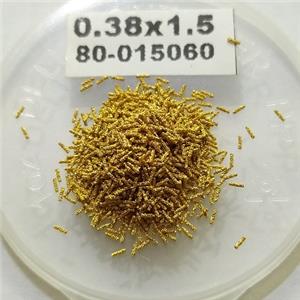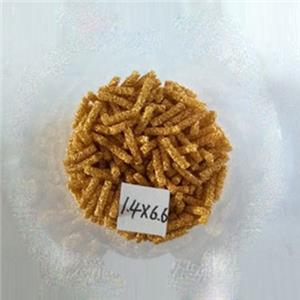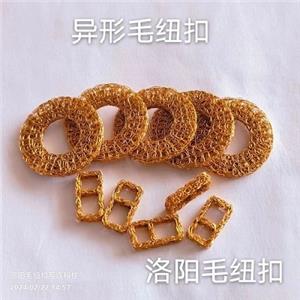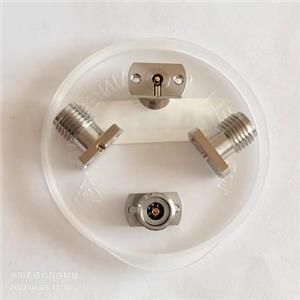Characteristics of typical mm wave coaxial connectors
Characteristics of typical millimeter wave coaxial connectors:
1. SMA connector
SMA connector has a working frequency of 22ghz, it is not a millimeter wave connector, but it has a great impact on the development of millimeter wave connector, so it is necessary to introduce it first. SMA was designed by Bendix for semi-rigid coaxial cables in the late 1950s. The matching space is filled with polytetrafluoroethylene medium, and the structure is relatively simple. This kind of connector was not intended to be used for a long time, nor considered as a precision connector, so it is just a connector for common system. At that time, because of its small size, it can work at a higher frequency, and it quickly gained popularity. Even when it developed a new generation of millimeter wave coaxial connector later, it had to consider compatibility with it. However, due to its congenital deficiency, it also brought some limitations for the later development of small coaxial connectors. The main problem of SMA is that the accuracy is not high and it is not suitable for the needs of test equipment; secondly, the wall of outer conductor is thin, and the jack of inner conductor is two slot structure, which is very easy to be worn and damaged in use; secondly, the frequency of use is not high, which can not meet the needs of the system with working frequency band up to 40 GHz. Due to these defects of SMA, some manufacturers have developed a batch of connectors that can be compatible with SMA. The main models are 3.5mm, wsma and later 2.92mm, mpc3, KMC and wmp4. These connectors overcome the limitations of SMA and are different from SMA in structure. In terms of contact area of outer conductor, the newly developed connectors are greatly strengthened and the robustness of connectors is improved.
2. 3.5mm connector
In the mid-1960s, the U.S. Department of Commerce established a Joint Industrial Research Association (jirc) for the standardization of small precision coaxial connectors. After efforts in 1972, it proposed a civil product standard. The size of the air transmission line was reduced to 3.5mm, and the frequency was expanded to 36GHz in the modeless working state. Then a 3.5mm mandarin duck connector (the same head seat) is introduced. However, due to its high precision and high price, it is hindered to be widely used as a universal connector. Due to the needs of the situation, Hewlett Packard and other companies have developed a kind of 3.5mm connector with high precision and low price. The mating space is filled by air medium. The inner conductor Jack adopts the slot free structure. In fact, a slot free protective sleeve is added outside the slot Jack. Rated working frequency is up to 33ghz. It chooses a large enough distance between two insulators, 0.50 talents (12.27mm), 3.5 times of D. 3.5mm connector can be compatible with SMA and can be connected without damage. In the working frequency range of SMA, the VSWR of 3.5mm connector is similar to that of SMA. 3.5mm connector was originally designed as a low-cost attempt to replace SMA, but it failed to form a batch in time to achieve the purpose of reducing cost in advance, resulting in the high price of 3.5mm connector, which is the reason why 3.5mm connector failed to replace SMA. 3.5mm connector is especially suitable for testing equipment due to its precision and good wear resistance.
3. 2.92mm connector
The 2.92mm connector is similar to the connector in structure, but smaller, with the allowable working frequency of 46ghz and the inner conductor size of 0.05 inch (1.27mm) as SMA. The 2.92mm connector was first developed by Maury microwave company (mpc-3). These connectors developed by other companies include K type, KMC type, wmp4 type, etc. The k-connector was developed by wiltron in 1983. It is compatible with SMA, 3.5mm and wsma connectors. The heart of k-connector is its transition device. It uses a glass insulator to realize the rigid transition from coaxial connector to microstrip circuit, which ensures that the circuit will not be damaged when the connector is replaced or repaired.
The reliability of MMW coaxial connector is affected by the insertion and pull force, the strength of outer conductor, the stress relief during mating and the concentricity during mating. K-Connection has good performance in these aspects. Under normal circumstances, the plug-in force of k-connector is 0.5 pounds (2.22n) and SMA is three times of it. The wall thickness of K-type outer conductor is four times that of SMA, and its reliability is 30 times that of SMA, which has been proved by tests. The test shows that the electrical performance of k-connector has little change after 10000 times of plugging. It is especially suitable for system and test instrument.
4. 2.4mm connector
The successful development of 2.4mm coaxial connector marks a new step in the development of millimeter wave connector. A series of small coaxial connectors developed in front of it have made a lot of improvements in the structure, but the robustness and repeatability of the connectors are still not improved enough. This causes a series of problems in instruments and calibration standards, because these places need to have higher alignment, firmness and repeatability. For example, when it is used with SMA, because the size tolerance range of SMA is very large, the fault of increasing the outer diameter of the female central conductor (Jack) can happen occasionally, and the high-frequency covering capacity is small, and the central contact body is also very fragile (easy to break). Therefore, it is urgent to develop a new type of coaxial connector, which requires no mode operation to 50GHz, high robustness and repeatability, and the ability of anti accidental fault. Under such a new requirement, Hewlett Packard, Omni spectrum, amphenal and other companies have developed a new generation of small 2.4mm connector. Two point four
Floss Pin® i.e. Fuzz Button or CIN::APSE is a patent product of Luoyang Fuzz Button Interconnect Technology Co.,Ltd. It is the most reliable and advanced welding compression-style interconnect technology。It provides the board-to-board advantages for high-speed telecom,stringent military and aerospace,and demanding automotive applications。
It is the ideal interconnect solution for vertical interconnection of the microwave module,Ideally suited for applications in which high reliability,high-speed signals,tight envelope dimensions,high density,and extreme environmental conditions need to be met。
We are the first company successfully developed and mass production the Fuzz Button® or CIN::APSE® in the China。The product performance is leading inChina, and the key parameters have reached the level of similar products such as Fuzz Buttons® from USA.




